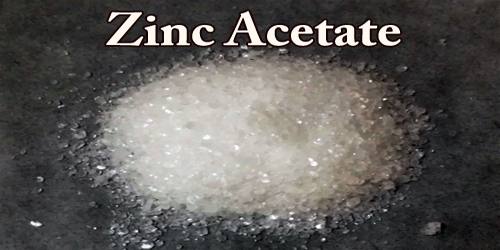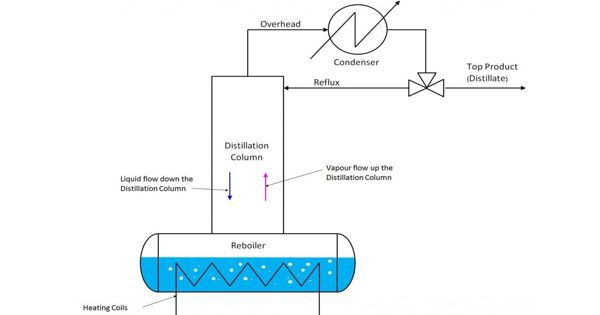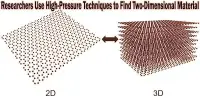Zinc Acetate is a white or almost white crystalline powder or flakes; it is an acetate salt in which the cationic component is zinc (2+). It has a role as an astringent. It is a zinc molecular entity and an acetate salt. Its chemical formula Zn(CH3CO2)2, which commonly occurs as the dihydrate Zn(CH3CO2)2·2H2O. Both the hydrate and the anhydrous forms are colorless solids that are commonly used in chemical synthesis and as dietary supplements. It is also called Zinc diacetate or Dicarbomethoxyzinc or Acetic acid, zinc salt. It can be obtained by reacting zinc oxide (ZnO) with acetic acid. It is widely used as an emetic, astringent, and styptic.
Zinc acetates are prepared by the action of acetic acid on zinc carbonate or zinc metal. When used as a food additive, it has the E number E650. Obtained in both in two forms viz anhydrous and dihydrate form. It is a white crystalline solid. It functions as an astringent. It is an acetate salt as well as a zinc molecular entity. The primary hazard is the threat posed to the environment. Immediate steps should be taken to limit the spread to the environment.
Zinc can be used for the treatment and prevention of zinc deficiency/its consequences, including stunted growth and acute diarrhea in children, and slowed wound healing. It is also utilized for boosting the immune system, treating the common cold and recurrent ear infections, as well as preventing lower respiratory tract infections.
Inhaling Zinc diacetate may cause mild irritation in the throat and nose which leads to sneezing and coughing. Swallowing causes corrosion or irritation of the alimentary tract which results in vomiting. It is a non-flammable compound.
Zinc acetate has been used in lozenges for treating the common cold. Zinc acetate can also be used to treat zinc deficiencies. As an oral daily supplement, it is used to inhibit the body’s absorption of copper as part of the treatment for Wilson’s disease. Zinc acetate is also sold as an astringent in the form of an ointment, a topical lotion, or combined with an antibiotic such as erythromycin for the topical treatment of acne. It is commonly sold as a topical anti-itch ointment.
When anhydrous zinc acetate is heated in a vacuum, the compound loses acetic anhydride and a black residue of basic zinc acetate is obtained. This black residue can be considered as a cluster compound which has a tetrahedral structure. It can be noted that this compound is quite similar to basic beryllium acetate. It can also be noted that when zinc acetate is heated to 237 degrees Celsius, it undergoes a decomposition reaction. Therefore, this compound does not have any specific boiling point (since it decomposes before reaching any specific boiling point).
Zinc acetate USP is used as an astringent in low concentrations and an irritant at high concentrations. It also has mild antibacterial actions similar to those of zinc sulfate. When applied to cuts, it exerts styptic action. Industrial applications include wood preservation, manufacturing other zinc salts, polymers, manufacture of ethyl acetate, as a dye mordant, and analytical reagent. It is used in commercial nuclear power plants as a plating inhibitor on primary water piping.
In a study with human volunteers, most of the zinc in a zinc acetate solution (0.1 mmol/L) administered by intestinal perfusion was absorbed from the jejunum, followed by the duodenum and the ileum (357, 230 or 84 nmol/ liter per min per 40 cm respectively). The absorption showed a linear increase at concentrations of 0.1- 1.8 mmol/ L.
Heating Zn(CH3CO2)2 in a vacuum results in a loss of acetic anhydride, leaving a residue of basic zinc acetate, with the formula Zn4O(CH3CO2)6. This cluster compound has the tetrahedral structure shown below. This species closely resembles the corresponding beryllium compound, although it is slightly expanded with Zn-O distances ~1.97 vs ~1.63 Å for Be4O(OAc)6.
Zinc acetate is soluble in water. At a temperature of 20 degrees Celsius, the dihydrate form of zinc acetate has a solubility of 430 grams per liter in water. It can also be noted that this compound is also sparingly soluble in other organic solvents. For example, the solubility of zinc acetate in methanol corresponds to 15 grams per liter.
Zinc acetate is designated as a hazardous substance under section 311(b)(2)(A) of the Federal Water Pollution Control Act and further regulated by the Clean Water Act Amendments of 1977 and 1978. These regulations apply to discharges of this substance. This designation includes any isomers and hydrates, as well as any solutions and mixtures containing this substance. Zinc acetate is an indirect food additive for use only as a component of adhesives.
Information Sources:
















